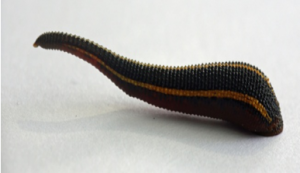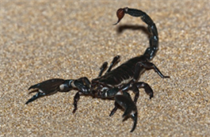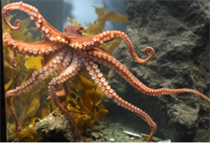Organisms in Kingdom Animalia are classified into different phylum including Porifera, Cnidaria, Ctenophora, Platyhelminthes, Aschelminthes, Annelida, Arthropoda, Mollusca, Echinodermata, Hemichordata, and Chordata.
Here, let us know in detail about the higher invertebrate animal phyla.
Characteristics Of Higher Invertebrate Animals
Phylum Annelida
Earthworms and leeches belong to this category. The characteristics of phylum Annelida are:

Example of Phylum Annelida is Leech
- They could be aquatic or terrestrial, free-living or parasitic.
- These are coelomate as they have a true coelom. This means that the coelom or the body cavity is enclosed by the mesoderm on all sides.
- They are triploblastic and have bilateral symmetry.
- They have a closed circulatory system, which means that blood is circulated through blood vessels and never leaves them.
- They show metamerism, which means that in their body similar segments are repeated.
- They have organs called nephridia for excretion.
- Aquatic annelids have appendages called parapodia for locomotion. All annelids have setae, stiff bristle-like structures for attachment.
- Their nervous system consists of paired ganglia (collections of nerve cell bodies) and a double ventral nerve cord connected by lateral nerves.
- They undergo sexual reproduction. Some of them are dioecious (unisexual) while others are monoecious (bisexual).
Phylum Arthropoda
Among all the phyla of this Animal kingdom, this is the largest animal phyla. These include insects, prawns, crabs, spiders, scorpions, millipedes, and centipedes.

Example of Phylum Arthropoda is Scorpion
Let us look at the characteristics of Arthropoda
- These are triploblastic, coelomate, bilaterally symmetrical
- These have appendages with joints for locomotion (arthros = joint, pods = feet).
- They are segmented like Annelids.
- Their body is protected by a tough covering called an exoskeleton, made of chitin.
- Their body is divided into three parts viz. head, followed by the thorax, and finally the abdomen.
- Different arthropods respire using different organs such as tracheae, book lungs, book gills.
- They have an open circulatory system, viz. the blood flows out of the blood vessels into the body cavity and the tissues are bathed in blood.
- Sense organs like compound eyes and statocysts are present.
- Excretion is done by various organs such as malpighian tubules and green lands.
- They are dioecious and development is often indirect, which means that they have a larval stage.
Phylum Mollusca
This phylum of this Animal kingdom includes animals like snails, clams, oysters, octopus, and squid.

Example of Phylum Mollusca is Octopus.
The characteristics of phylum Mollusca are:
- Their body is divided into the head, foot (a large organ used for locomotion) and visceral mass(all the organs are contained in this).
- Their head has antennae with eyes.
- A soft covering called the mantle covers the visceral mass.
- The cavity between the mantle and the visceral mass is called the mantle cavity, in which gills and osphradium (organ to sense the chemical nature of water) are present.
- In most molluscs, the mantle cavity is covered by a calcareous shell.
- Their mouth has a rasping organ called a radula.
- They have an open circulatory system.
- They are dioecious and development is indirect.
Phylum Echinodermata
These include marine invertebrates such as starfish.

Example of Phylum Echinodermata is Starfish.
The following are the characteristics of phylum Echinodermata:
- They are radially symmetrical, but their larvae are bilaterally symmetrical.
- They have a calcareous endoskeleton.
- They have a water vascular system, constitutes a network of channels. It has two functions: the first one is the circulation of seawater through the body (for the exchange of food, waste substances and gases), and the second one is locomotion by tube feet which are a part of this system.
- They are dioecious and development is indirect.
Phylum Chordata

Example of Phylum Chordata is Hemichordata
The following are the characteristics of phylum Chordata:
- They are a worm-like marine
- The body can be divided into an anterior proboscis, followed by a collar and then a trunk.
- They have an open circulatory system and respire through gills.
- They are dioecious and development is indirect.
Also Read: Kingdom Plantae, Animalia, Viruses
For more detailed information about the classification of animals, Kingdoms Phylum, and subphylum or any other related topics visit BYJU’S Biology.

I love everything about you because it helps
It clear all my doubts
I love this application
love it
It helps me a lot